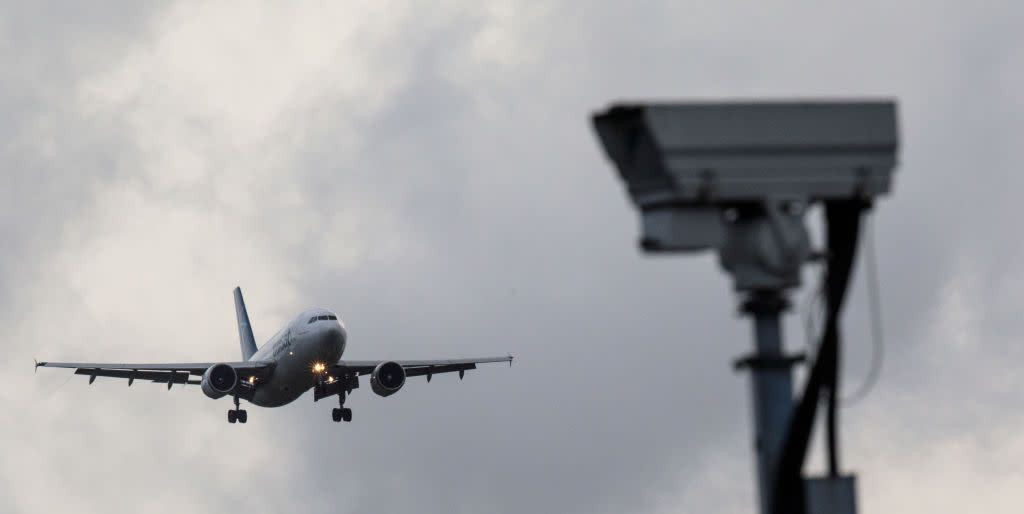We Still Have No Idea How to Deal With Drones

London's Gatwick Airport, one of the biggest transportation hubs in the United Kingdom, was effectively shut down for nearly 36 hours due to drone interference near its runway. The airport has slowly emerged from the paralysis, with a small number of flights embarking on Friday morning, but the drone and its operators still remain at large.
The incident threw Gatwick into chaos and confusion during the busiest travel period of the year, with hundreds of flights cancelled and thousands of travelers stranded. It's unclear how many drones caused the disruption, though police claimed "dozens" of sightings between late Wednesday and Thursday evenings.
Authorities have identified "persons of interest," fueling speculation it could be part of a coordinated effort to shut down the airport, perhaps by environmental activists or foreign adversaries.
While authorities ranging from Britain's Department for Transport (DFT) to the Royal Air Force (RAF) have responded, they've largely been confounded by the mere presence of a drone hovering above the runway, and certainly were not readily-prepared to disable it.
Friday 15.00: Our runway is open and aircraft are arriving and departing. There are knock-on delays and cancellations to flights and we continue to recommend that you check the status of your flight with your airline before setting out for the airport today. pic.twitter.com/FqqT5ljiLH
- Gatwick Airport LGW (@Gatwick_Airport) December 21, 2018
Authorities' ultimate inability to disable the drone, locate its operators, or nail down the specifics of the incident bring more attention to a question that's only getting more relevant: In a world where airplanes and UAVs share airspace, how will we mitigate the chance of a cataclysmic accident between a drone and a passenger aircraft? It's a tough question with two equally complex facets-one practical and one procedural. At Gatwick, we saw both at play.
Practically, there's the question of how you take down the drone in the first place. A popular choice is signal jamming, a method widely-used in the fight against ISIS. Anti-drone jamming guns send robust waves of energy to the drone's operating device, effectively commandeering the UAV, which can then be ordered to land. According to London's Evening Standard, the military at Gatwick is now equipped with signal jammers and a sniping unit in the event of the drone's return.
There's other ways to stymie a rogue drone, many of which differ widely in approach and have their own pros and cons. One method involves good drones intercepting bad ones with a net. Others, like the variety preferred by police in the Netherlands, involve the use of highly-trained eagles to pluck drones from the sky. There's always the possibility of blasting it with a powerful, high-range firearm, too, although that's proven to be a highly-litigious and questionably legal act, and one that can come with enormous safety and liability concerns.
What's worse is that there's little to no consensus, and virtually nothing in the way of government approved standards, on which of these methods to apply, or when to apply them, or how. That's why, though the military was present at Gatwick, it largely waffled on whether or not to shoot the drone from the sky while the airport remained closed.
Gatwick’s chief executive Chris Woodroofe explained the conundrum in an interview with The Guardian:
“This is an unprecedented issue. This isn’t a Gatwick Airport issue. It’s not even a UK issue. It’s an international issue. We have been working with technology providers ourselves for the last 12 months but stood here today, there is no commercially available airport licensed proven technology that I could implement."
Woodroofe is right that the Gatwick drone debacle will have wide-reaching implications. It's shown how easy to is to completely shut down an airport using a 21st century toy and how little there is to effectively deter it.
As flights resume and dust settles, it's clear that aviation authorities the world over are ill-equipped to deal with an issue as simple as a consumer drone looming over an airport. It's a problem that may have to get worse before it gets better
('You Might Also Like',)

